
Replacement Trailer Hub Bearing - L68149

Thank you! Your comment has been submitted successfully. You should be able to view your question/comment here within a few days.
Error submitting comment. Please try again momentarily.
- All Info
- Reviews (341)
- Q & A (0)
- Videos (2)
- Photos
etrailer Trailer Bearings Races Seals Caps - L68149
- Bearings
- Standard Bearings
- 3500 lbs Axle
- 1.378 Inch I.D.
- Bearing L68149
- etrailer
- Race L68111
High-quality, tapered roller bearing is designed for high-speed use. Replacement part uses industry-standard number.
Features:
- Inner diameter: 1.378"
- Matching race (sold separately): L68111
- Application: inner bearing for #84 spindle
L68149 Replacement Bearing
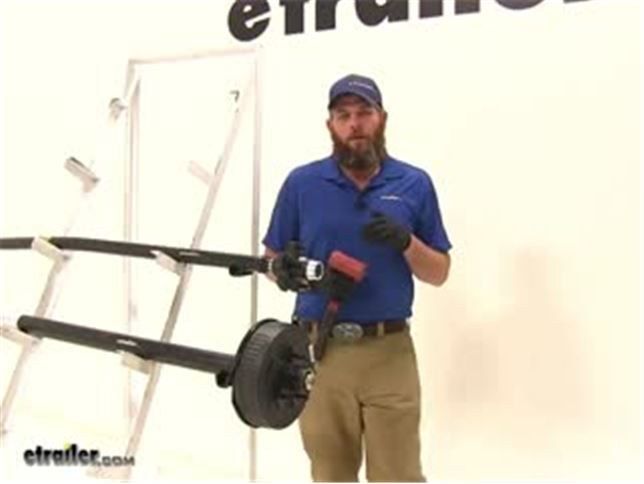

Videos are provided as a guide only. Refer to manufacturer installation instructions and specs for complete information.
Video Transcript for Trailer Bearings Races Seals and Caps Rebuild
Speaker 1: Today we're going to take you through the rebuild process on a couple of hubs. We've got an idler hub, and here we've got a hub and drum assembly. Works with electric rigs, but this can also work for just standard discs, if you've got a disc brake style setup.Basically what we're going to show you is how to get all of the bearings out. How to remove the seal. How to remove the race's if they're damaged, then get them replaced in the proper manner. We'll show you how to use an easy loop hub, which we have here.The first thing we are going to need to do is, get the grease cap off the end.
It can have either a rubber plug in it like this one does, or it can be a solid metal cap.These are pressed fit in there, basically by tapping on them on the back side. To remove them, a deadbolt hammer is typically what we're going to use. We're just going to start tapping as we go around. You'll see a little separation start right here, and slowly it'll work it's way off.Now the next step's going to vary a little bit depending on your axle setup. Do you see this is going to have a keeper that goes around the nut.
And that prevents that from being backed off, or removed. A lot of times you'll have a castle nut, which will have just little tabs that stick off, and there will be a cotter pin that passes through it. Just depending on your application, you need to get the keeper for the nut off. This style we just kind of pry out. A cotter pin you would just remove of course.Once we have that off ...
We'll start to take off the nut here, and the washer that's in behind it. Now yours should look a whole lot more dirty than this. There should be a lot of grease packed in, and through the hub, this one's brand new. We thought it'd be nice to show you the components before the grease was on .. Of our washer that comes off.And then here we're going to have our outer bearing.
Continue to pull that. We're gonig to have our inner bearing here. That sits in the backside of the hub. And we didn't put it in yet, we will show you how to put it in. But a seal would typically be covering the backside here. We'll show you how to use a seal removal tool, or another tool. To get that pried up and out. To get an access to that inner bearing.Now for a drum style like this, that process for disassembly is going to be just the same. One thing to keep in mind if you're using a disc brake setup. You'll have to remove the caliper before the disc is going to come off.Now once we have the spindle exposed, as we said this is going to be really greasy. We want to get all the grease removed, and the first thing we'll do is inspect it. We want to make sure that it looks just like what we have here. Everything's nice and smooth. We don't see any kind of discoloration, or any marring on the metal. Indicating that our bearing's got hot.If you do have any of those symptoms, at this point it's time to replace those bearings. You don't want to repack them. Get new bearings, and put in there. You might have a bearing that's come apart in here. Another surface to ensure is in good condition, is where your seal is going to go. That helps seal all the grease inside of our hub. With a damaged or broken seal, that grease is going to seep out. Either out of the hub, or in this case into our brake assembly.Now if your axle has brakes, we're also going to check the disc. Make sure it doesn't have any issues, or your hub. And this is going to be a hub and drum assembly. The brakes are going to ride on this machine surface. You're going to check that for signs of excessive heat, discoloration, or cracking. And this is our magnet surface. We'll check that surface for the same issues.Now inside the hub regardless if it's a disc brake, it's a drum brake like this. Or just a standard idler style hub. You're going to have an outer race. Would be right here, it's a small tapered piece of metal your bearing sits in, and rotates on. That's basically the outer portion of the bearing.You have the same thing here on the backside. This is called the inner race. Now if those show any signs of wear, overheating, or cracking. Those are also something we'll need to replace, which we'll show you how to do in just a minute.Now, with your brake assembly exposed, if you do have electric brakes like we have here. It's a good idea to check all the components for wear, cracking, maybe missing pieces. Check your pad thickness to make sure those are in good shape. Basically if you have a non working brake assembly and you put everything back together, you're just going to have to take it apart and do it all over again to get back to the brake assembly. This gives you a really good option to be able to change them out.And most applications are going to use a four, or maybe a five bolt flange to hold them in place. And you'll just remove the lock nuts, or sometimes you'll have a hex nut with a lock washer. You want to remove those, and then simply slide your assembly off after you cut the wiring.The friction material itself should also be checked for any kinds of cracking, or overheating. If you have any grease inside the system at all, it's likely it's gotten on those pads. It's a good idea to get those changed. Now as far as the removal of the races go, it's going to be just the same whether we're using an idler style hub like we have here. A drum brake like we have here. You can basically see where the idler is, here in the middle of the hub. It's going to go all the way around there, and we just have this extra material here to provide our braking surface.Now if you're doing a disc brake style job again, it's going to be just the same here with the races living inside of the actual hub portion. You'll just have the discs there for the brakes to make contact. We're going to use this little bit smaller one, it's a little bit easier to manage to show you how to get these out. We've talked about where the races are. The outer here, the inner being closer to the inside, but on the backside of the race there's a little lip. That lip's meant to stick out just a little bit further than the hub, and provide us an area to put our tool on, and help to drive that out.If you look all the way through there on that inner race, you'll see that little lip that sticks out just from the hub slightly, and it gives us enough area to use our tool on. Now generally to remove these you're going to use a punch, similar to this. Some guys will use a screwdriver. Or a piece of pipe. If you have a piece of pipe that's small enough to fit inside of that diameter, you can take that down through and allow it to rest on that lip.Use our punch, and then just need a hammer. And we'll start working that out. We're going to tap all the way around. Kind of equally, and evenly apply the force to get it to come on out of the bottom for us.You can see now as it starts to come out there's going to be a little gap created between the hub and the race. And we can just keep going, bringing it on out. Then you can inspect the inside of the hub surface there. Make sure no damage or anything has occurred, and repeat that same process for the outer race if you plan on removing and replacing that one.Now in the outer flat edge, you can see we're going to have our tapered edge on this side. If we roll our race over to the flat side, typically there's going to be a manufacturers part number on there. That will help you identify which race it is, that you need to go back in your system. If those are rubbed off, worn off, if you can't read them. You can measure the outside, to outside diameter of the race here. It's a good idea to use a micrometer to get it exact.Now here's your basic micrometer. And again, the outside of the race is what we're going to need to measure. You want to go . I set the thickest point there. Looks like this one's going to be about 1.98. That's going to be the measurement you'll want to supply.Now while we've got this out, let's also look at the proper way to measure our bearing. Instead of the outside for the bearing, we need to measure the inside diameter. That's going to be pretty simple. Let's pull that out, find the largest measurement we can. Which here, looks like it's going to be 1.03. With that information, we'll be able to get the correct bearing, and the correct race, so they'll fit together properly and make a full bearing kit for us.Now here's the race, we're going to show you how to get this put back in. Basically just going to press fit inside of our hubs. We need to get it down on there. Kind of like that. And you'll have a couple options. A lot of times you're going to see do it yourself or at homer, just going to use a wooden block. Just place it on there. That's going to get you started, but at that point you'll struggle in getting it to go all the way down into it's seat.Now to take care of that problem, there are several seal drivers that are available. Seal and race drivers that are available out there on the market. It's designed to fit down inside of our race, inside of our hub and get it down there where it needs to go. This is part number ptw83020, has several different sizes, even if you have multiple trailers it's going to do the job.Now the side with the angle on it, is designed to fit down inside of our race. If we use the other side, that's going to be for driving your seal into place. Just want to hold it, and take it on in with your hammer. You'll see, you just want to insure that our race is all the way up against that line on the hub where it's supposed to mate to.Now when it comes time to pack your bearings you're going to have several different ways of doing this. You can just use your hand, is the traditional method. That's going to be the method probably reserved for the very occasional trailer work kind of situation. If you do it once or twice a year, probably get away with it that way.Next you would go to a, kind of a sandwich funnel style almost. If you look inside of there, you can see the bearing. It's located between the two pieces. Just use a grease gun. Start filling that with grease, and that's going to fill our bearing for us. And the third, with this one you're just going to place your bearing down and in. It should be pretty close to center. And then we've got our cone her that's going to go down and secure that.Now I think this style, wastes a little bit more grease than what this style will. This has a dust cap. You can see, you can keep your grease in there, put your dust cap on there and save it for later use. This will be if your going to do it every couple years. And this particular style would be if you're a more regular user.Let's start by showing you how to use a bearing packer. Similar to this. Again, we've just got our grease inaudible 00:11:07 here on the top. And then just slowly start to fill it. Now I like this style quite a bit. I think even regular users might enjoy it, because you can get a really quick visual look at that bearing. You're not going to have to overdo it, or have to much grease.You can kind of see in there now, we're starting to get grease to come out of it. Couple more pumps, we'll be good. You can see we've got grease coming out all the way around. Where all of our bearings are. Got a little bit of excess there. Just take that around the outside of it. And then we should be able to lift it off. And now you can see what we we're talking about. Just a little bit of excess there, that you're just going to wind up wasting.Now we'll take our bearing, we're going to place it right down in our race. And then we'll cap off the back with our seal. Right now our seal's going to fit in just like our race did. It's going to have a little bit of a pressure fit to it. Now very often in this situation, I see people using the four by four method. Kind of here, just placing that on and tapping it. As an option though, if you do have one of these. You can see that's designed to fit right on the top of the seal. And help drive it in.The biggest thing here is, just going to be getting it driven in squarely. You can see, this side's in a little bit further than this side. I'm going to start this side first. Now since we didn't have the opportunity to show you before, we're going to take a look at pulling a seal. Now this is a seal puller, we carry this on our website part number ptw1219. This is meant to hook underneath the seal. And then you kind of pull up on it, and just like our race you'll have to work all the way around that edge. Just bringing it out a little at a time.If you don't have that available. Another option would be a screwdriver. You just kind of get that under the seal, and turn it. And see, that'll allow you to also pop that out. We've taken care of our race. Our inner bearing. Our seal. The last component, before we put our hub back in place is going to be our outer bearing. Now with this bearing, I'll show you the hand packing method.This is definitely . Slightly dirtier method than the bearing packer. When we get grease on our hand we want to look at the larger side of the bearing. This is the smaller side. We have a larger side In between the inside and outside there's a gap. We can see our rollers in there. We want to grab that, and use that gap and shove grease inside of it. Now this is going to take a little bit, you want to work in the same spot until you get the grease pushed all the way through. We can see on the top there we've got a little bit starting to come through.And once we push it in the bottom, and you see it start coming out the of the top in those little drips, it's going to indicate that, that section's fully packed. Just need to work all the way around their outside edge now and do the same thing. Alright, once that's all the way around . The bearing will be ready for use.Now one more thing I like to do. We can see our inner bearing there, and our outer bearing. Well between the two, got a pretty big gap in there. If you'll take a . Pretty good amount of grease. We're just going to go all the way around. See how we can go all the way around the inside and just line that really well. The more grease we have in here, the less chance we have of any moisture getting in there, which can cause corrosion, rust, pitting. Pretty much things we do not like when it comes to bearings, races, and hubs.Put plenty of grease in there. And then this one does have the easy lube spindle, that'll even fill it in more. Now we can get our assembly slid on. I like to keep my thumbs on that outer bearing, just to prevent it from . inaudible 00:15:28 pushed off there. Now we can put on the original hardware that we removed, in taking off our hub the first time. In our case, we had our washer and our nut.Now most commonly you'll see pliers similar to this being used. We basically want to get that tightened down. Once it's fully tightened down you'll feel some resistance in the hub. We back it off just slightly. That'll give us a little bit more freedom of motion there. Something you don't want however . Is any movement in, or out on your hub. You want to be sure that everything is compressed, and you don't have what's called end play. Which would be the play in and out.Once we've got that set, then you'll put on whatever tight keeper yours came with. Get that put back in place. Now with an easy lube style hub, you're going to place your grease gun on the end, and then you can just fill the remainder of that hub up.Now for your typical applications, you're either going to have a solid cap, or a cap that'll have a rubber plug in it. A solid cap's going to be for an axle without the grease inaudible 00:16:51 here on the end. Goes on there. Just knock it on with your rubber mallet. Same with the one with the plug. Just gives you a removable area there, be able to cap that off.We'll show you how to put that on. Now as alternatives as well, a lot of times on boat trailers and marine kind of situations. You'll see a bearing buddy. This is going to apply a little bit of pressure on the grease, you'll fill it up. This kind of comes out just a little bit. That applies constant pressure on the grease to make sure we don't have any air, or anything like that. Then there is also an oil bath hub available. Now this is going to be for use with seals that are going to be designed specifically for oil bath use. You'll have to change that seal.We're using a double lip seal. There are also single lip seals available. Of course a double lip seal is going to give you just a little additional security. Keep that in mind when you order. But let's get this knocked on there now so you can see how that works. We just want to take the cap, we're going to center it. This is going to be very similar to what we did with the seal. And then just gently start tapping it around the outside. And it'll seep down on there for you.It's really going to be the same thing that you'll do with any of the end caps. Now with this side done, it's a good idea to take care of all the other hubs. Get them all on the same maintenance schedule. And as long as you'll periodically check the grease, take your trailer out for a trip occasionally. Just to keep everything lubricated. It should extend the life of these parts, and give us years of good service.
Customer Satisfaction Score:
99% were satisfied with this product
1% of customers were not satisfied
- Wrong item was ordered
- etrailer mistake
- etrailer mistake
Customer Reviews
Replacement Trailer Hub Bearing - L68149 - L68149
Average Customer Rating: 4.7 out of 5 stars (341 Customer Reviews)
High-quality, tapered roller bearing is designed for high-speed use. Replacement part uses industry-standard number.
The bearing it average, I trailer my boat 60 miles each way alway making sure problems free. in 6months fishing season I remove hubs to inspected bearing 3 time adding more fresh marine grease check those bearing found after the 3th trips bearing start to make little noise not what I expected and the price higher than some company’s yes this year 2023 I did switch out different manufacture.
What sets e-trailer apart from just about everyone else is their outstanding customer service and support, both before, and after the sale. This order here was just a simple, inner bearing for my Jayco camper. I did have to contact Lippert - the company that makes my axle to ensure this would fit (and it does). I am ordering parts now as I need them from E-trailer instead of the manufacturer. While it's a bit unfortunate that it's so hard to know for sure what will fit and what wont without doing legwork yourself, I understand why that's just the way it is. Their shipping is quite a bit faster, prices are fair. I am happy to endorse etrailer and have additional orders in the queue already.
Quality productas and quick service.
China bearing. Probably ok for a trailer. Again, just thrown in a box. No individual packaging.
Excellent service.
good bearings. would buy again.
This rating is for the packaging only, shipped very poorly with no protection. four sets of bearings thrown in a box,
Had to return. (photo enclosed).
flawless transaction, customer service was a huge help finding the correct parts.
I didn't realize bearings and races were sold separately. This was my misunderstanding and I should have ordered them as a kit. Thank you for your patience and I really appreciate your research on what bearing I needed because the outer bearing wasn't marked with an ID number. Your personnel was very helpful in getting me the correct parts. Thank You!
My sales person Eric was great. He made sure I got the exact bearings and grease seals I need for my travel trailer with the part numbers I provided.
My Average rating is based on the packaging. The 8 bearings were shipped loose in the box free to bounce around against each other and the 4 Center caps in the box as well. 1 of the 4 center caps had scratches on it because of that and because it wasn't wrapped at all (3 were wrapped).
Want to help out the next customer looking for the bearing, cups, and seals for 2000-01 tracker trailstar trailer. 1st you have to dismantle one of the hubs and see what trailstar decided to put in there the day they built it. You will find the rear cups and seals are considered "Special for some reason". Not a problem for etrailer, they have them in stock and the quality is excellent and are exact replacements. The parts I had to order were cup L68110, cup L44610, seal 168233, bearing L68149 and bearing L44649. Oh yeah, customer service should get a 10 star review. I had an issue with shipping co. because of new driver in my area. Etrailer got all up in their business for me and I didn't have to do anything. Customer service also called me the next day to see if everything was delivered and satisfactory. We need more companys like etrailer.com . Excellent!!
Ordered trailer bearings and bearing buddies for RV.
Fast shipping, items priced below anything retail nearby, looked to be good quality. Bearing buddies install went smoothly.
Definitely will be repeat customer!
Thanks!
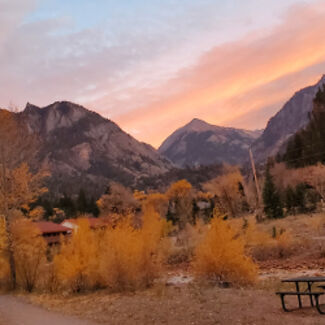
Glen C.

5/1/2015
Fit and forget - takes the worry out of bearings, still going strong!
Want to help out the next customer looking for the bearing, cups, and seals for 2000-01 tracker trailstar trailer. 1st you have to dismantle one of the hubs and see what trailstar decided to put in there the day they built it. You will find the rear cups and seals are considered "Special for some reason". Not a problem for etrailer, they have them in stock and the quality is excellent and are exact replacements. The parts I had to order were cup L68110, cup L44610, seal 168233, bearing L68149 and bearing L44649. Oh yeah, customer service should get a 10 star review. I had an issue with shipping co. because of new driver in my area. Etrailer got all up in their business for me and I didn't have to do anything. Customer service also called me the next day to see if everything was delivered and satisfactory. We need more companys like etrailer.com . Excellent!!

After a year no problems. Packed bearings with proper bearing grease and the hubs run cool and smooth. Very pleased with both the retailer tires and bearings.
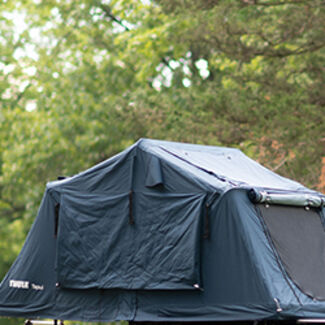
Ben

10/23/2017
Doing well after a year for my utility trailer. A good mix of highway and city driving with loads under 2000 lbs.
I got the email notification that the package was delivered before I went to the mailbox.This digital age is amazing. And the delivery was a day ahead of promised.
I haven't installed them yet but I would like to complement
etrailer on the tech support. I have a 19 year old Tracker trailer. Every few years I replace bearings and always have a problem with finding correct parts, It seems the L68149 inner bearing uses 2 different races that are different in size. To make matters worse the existing inner race was not marked with the correct part number. L68111 instead of the correct L68110. I measured bearing sizes several times and was still not certain what was wrong. While chasing down what to order I found the answer in the etrailer FAQ page. Having the exact measurements for the parts really helped. I also found the perfect replacement for the damaged rubber part on the transom saver for the boat. Now when it warms up a few degrees I can get these installed and be ready to go fishing. Thanks, etrailer.

I put these bearings on a 21 ft travel trailer. The original bearings were poorly greased and got too hot. With these bearings and a good quality grease these bearings never overheated even with driving in hilly terrain with frequent breaking. Definitely recommend!

I had a hub and bearing go out on a boat trailer going down the road. Tried matching separate parts locally, but were not available. Was able to order all the parts from etrailer at one time. They had on hand and shipped right away. Parts were exactly what I was looking for. Perfect fit. Now if I would have known that the other side would have failed in the next 12 months I would have done them all at the same time.
Bearings are equivalent to the ones that you'll buy at any local trailer shop, however they were included with the specific brake drums that I purchased from etrailer so it was a no brainer! I needed them and they did the trick. I have done many bearing repacking jobs, however for the first timer, etrailer offers great videos on how to pack, install and tighten bearings. I watched the videos just for the heck of it and I can say they offer good solid advice.
no regard for quality with 4 bearing sets shipped loose in one plastic bag without padding or separation.
I am reviewing the components and etrailer as they are not installed yet. Online ordering was easy - I was contacted immediately with shipping time and tracking numbers - it all went really well. The components showed up on time and in good condition. The boxes were a little hammered but UPS does that. Thanks etrailer good service - good prices: what else do you want?
Purchased bearing races, tapered roller bearings, seals and dust cap to have for spares for our 2012 Catalina Santara 281BHS travel trailer. Quality products .

Don't do what I did...spend 2 weeks trying to find the right parts locally, and end up trying to use a 67 Chevy seal on a 2002 boat trailer...it doesn't work. Just order the right stuff from etrailer.com and save yourself a lot of time, money, and hassle. If you just absolutely have to go the auto parts store, their brake cleaner is pretty handy for removing grease from the trailer parts without removing the paint.
Bearings and seals in stock, delivered fast and exactly what I needed. Thank You for your great customer service..... ready to transport my boat 1000 miles to Florida....Jim
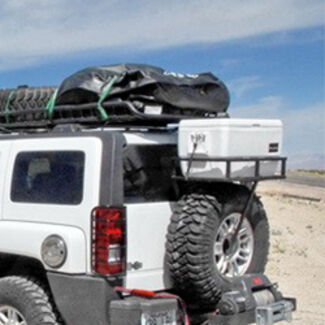
Jim

1/5/2015
everything is fine and working the way it should, Happy New Year

I bought the brake this kit last year along with new bearings to replaced the existing brakes on our 2010 Jayco 23B. We went on eight different camping trips this year and they work great! We noticed a huge improvement when applying the brakes to slow down or stopping the camper altogether. I highly recommend this kit because they were easy to install and the noticed stopping power.Please feel free to ask me any questions regarding this kit.
See what our Experts say about this etrailer Trailer Bearings Races Seals Caps
- Picking Out Replacement Bearings for Grand Design Imagine RV Travel TrailerTo pick out bearings for a trailer hub you will need to remove one of the hubs so that you can remove the bearings and get the numbers off of them as we don't have a way to look up what a trailer uses based on brand. Or, you can measure the spindle where the bearings ride so that we can pick you out the correct bearings that would fit the spindle. Or you can get me the axle diameter or brand and capacity.
view full answer... - How to Determine Replacement Bearing for 3,500 lb AxleThe most popular inner bearing on a 3,500 lb axle is Bearing # L68149, though there is only one way to know for certain because of the variety of spindles. To do this you can take apart your hub assembly and look at the bearings themselves; wipe away the grease and you should be able to see the part number stamped directly on them. If you are unable to find them, you need to use a digital caliper to measure your spindle to the thousandths of an inch where the bearings ride. I've also...
view full answer... - I Ordered a # 84656UC3 Hub/Drum, Where are the RacesWhen your purchase the # 84656uc3 hub/drum, the races are already installed in the hub bore, as you can see in the photo I produced. Races are fairly easy to remove, but can be difficult to install without the correct tool. This is why the races are typically pre-installed.
view full answer... - Can an L68149 Bearing be Used to Replace an LM68149 BearingI am not quite sure what the M stands for but the # L68149 bearing will be an exact replacement for your LM68149 bearing. The M used to be used but was dropped as it became irrelevant in the part number side of things.
view full answer... - Ways to Identify Correct Replacement Wheel Bearings for 2000 Coleman Cheyenne Pop-UpThere are a few ways to find out what set of bearings is used in your trailer hubs. One way (the best way) is to pull a hub and remove the bearings to find their part numbers. Another way is to find the camper's VIN and contact Coleman with it; there is a chance they might have this information even though the trailer is 18 years old. The only other way, which again requires removing a hub, is to precisely measure your spindle at the 3 points shown in the linked diagram (B, C and D) using...
view full answer... - How to Choose Replacement Bearings and Seal for Utility TrailerI wish I could tell you based off of the picture you sent in what bearings work with your spindle but if you don't have numbers on your bearings then the next best thing is to take a digital caliper and measure where each of the bearings and the grease seal sit on the spindle to the 3rd decimal (for example 1.234). Replacement bearings and seals need to fit exact which is why it is important to use either the part numbers or the caliper. If you know the weight rating of your trailer axle...
view full answer... - How to Pick Out Hubs and Bearings for TrailerIn order to pick out the correct hub assembly for a trailer you are going to need know a few key pieces of information. The first thing you will need to know is the bolt pattern of your hubs. This is so you get a hub that is compatible with your wheels. I attached an FAQ article on determining bolt pattern for you to check out. Next thing you will need to know is what spindle you have on your trailer. In order to do that you can either get the inner and outer bearing numbers from a hub...
view full answer... - How to Pick Out Replacement Bearings/Races for a Wesco Boat TrailerThere are two ways to determine what would be the correct bearings/races you would need for a trailer hub. Once way is to remove the hub and get the numbers stamped on the bearings/races/seal. The other is to pull the hub and then using a micrometer get the dimensions off of the spindle and hub bore so that you can determine what would work based on that. See the picture I attached to see what needs to get measured and what the numbers should look like.
view full answer... - Replacement Bearing Kit for Bayliner Boat TrailerWe offer both individual bearings, races, and seals as well as complete bearing kits in many common parts combinations. The best way to know what parts you need is to obtain the part numbers from the existing bearings and seals. The linked photo will show you the typical locations and appearance of these part numbers. You can directly enter the individual part numbers on our site. This method is far easier than measuring. Measuring will requires a precision digital caliper and measurements...
view full answer... - How to Find Bearings For 4,000 lb Dura-Flex AxleI can tell you how to find the correct bearings for a 4,000 lb Dura-Flex axle, but there isn't any info available on what specific bearings that axles uses. So to find them, you will need to take apart your current hub assembly and look at the bearings themselves; wipe away the grease and you should be able to see the part number stamped directly on them. If you are unable to find them, you need to use a digital caliper and measure your spindle to the thousandths of an inch where the bearings...
view full answer... - How to Pick Out Replacement Bearings for a TrailerWe don't know exactly what bearings you would need for your trailer but I can tell you how to determine that information. You will want to take your hub off of your trailer and remove both the bearings, there will be a number stamped on them that you can use to determine which bearing you would need. Or if you use a dial or digital caliper you can take exact measurements for where your bearings ride on the spindle and I can determine what bearings you would need based off of that. If...
view full answer... - Removing Stuck Bearing from Trailer SpindleTake the wheel of the axle, remove the center cap/dust cover of the hub by lightly tapping it with a hammer to the sides and then using a slot screwdriver to pry off as needed. You'll see a nut with a tang washer or cotter pin behind the cover. Remove the washer/pin and then using channel locks or a large crescent wrench remove the castle nut that holds the hub on. Once thats off you'll be able to pull the hub off of the spindle. If the bearing is froze to the spindle you are going to...
view full answer... - What is the Difference Between Trailer Hub Race L68110 and L68111Both races you mentioned are related to the same bearing, # L68149. The difference in the races is the outer diameter. The outer diameter is important for the hub that the race fits so because the hub bore in the rotors is different than the hubs you have, they each take different races. In other words, it will work just fine. Disc brake kit T4843500 uses inner bearing L68149 and outer bearing # L44649 so as long as your trailer uses those bearings and has a 5 on 4-1/2 bolt pattern this...
view full answer... - Who Makes the Replacement Trailer Hub Bearing L68149The Replacement Trailer Hub Bearing part # L68149 like most trailer bearings if not all are manufactured overseas. This particular bearing is made by AxleTek. We have been using these trailer bearings for quiet some time and have heard nothing but good things in regards to their performance and longevity.
view full answer... - How Tight Are Bearings When Installing On SpindlesBearings will be pretty tight on the spindle when they are installed. They should not be so tight that you have to really pound on them to fit but they can require a little bit of effort to get them to slide onto the spindle. When installed there should be no play between the inner surface of the bearing and the spindle. If you are asking about the castle nut and how tight it should be, when installing you want to tighten the castle nut until it stops turning or is snug. Then look to...
view full answer... - Info Needed to Pick Out Replacement Bearings for TrailerI don't have a way to look up bearing kits by VIN number. To pick out bearings for a trailer hub you will need to remove one of the hubs so that you can remove the bearings and get the numbers off of them. Or, you can measure the spindle where the bearings and seal ride so that we can pick you out the correct bearings that would fit the spindle. With either info mentioned I can get you the correct parts you'd need.
view full answer... - How to Identify Correct Replacement Hub Based on Bearing Part Number or Spindle DimensionsThe bearings in trailer hubs are measured to very precise dimensions, to the nearest thousandth of an inch, such as 1.234-inches. To find a suitable replacement hub to fit on your existing trailer spindles either the bearing part numbers or these precise measurements are needed to ensure you select a hub that fits on the spindles. The new hub must use the same bearings as the original. If you refer to the linked photo you'll see how these part numbers typically appear on bearings. If these...
view full answer... - How to Pick Out Replacement Hub for UFP Hub Marked H-1377 A4EI can help you pick out the correct hub, but we don't have a cross-reference part number for the one you listed. In order to pick out the correct hub assembly for a trailer you are going to need know a few key pieces of information. The first thing you will need to know is the bolt pattern of your hubs. This is so you get a hub that is compatible with your wheels. I attached an FAQ article on determining bolt pattern for you to check out. Next thing you will need to know is what spindle...
view full answer... - Replacement Bearings For 2013 Aliner Expedition CamperI spoke with someone at Aliner and they said the replacement bearings for the 2013 Aliner Expedition Camper are the same as the 2014 model. You will have to measure the bearings on your wheel. I will include a diagram that explains how to measure the bearings, races, and seals. For example, if you have Replacement Trailer Hub Bearing - L68149, part # L68149, the inner diameter of the bearing is 1.378". I have included a product description link, video review link, and a weblink to the...
view full answer... - Replacement for NOK AD7128R Trailer Hub SealIn order to find the correct replacement grease/oil seal for a trailer hub you have a few options. The first would be to use a digital caliper and measure the spindle where the seal rides along with the hub. The second would be to measure the existing seal you have now. Please note, these measurements will need to be taken to the nearest thousandth of an inch. I have then attached a list of options below. Unfortunately, I am not able to cross-reference the part number of "AD7128R". I...
view full answer... - Method to Figure Out the Correct Replacement Hub AssembliesThank you for the information, but a bit more specificity is needed to ensure we get you the right parts. If you wipe away the grease, you might be able to see the part number stamped directly on the bearings themselves. If you are unable to find them, you would need to use a digital caliper and measure your spindle to the thousandths of an inch where the bearings ride. You can use the photo I've attached to see exactly where you need to measure. I've also added a link to a help article...
view full answer... - How to Find Out Which Replacement Wheel Bearings Needed for 1999 Bayliner Single Axle Boat TrailerTo get replacement wheel bearings, you'll need to pull one of your hubs and get the reference numbers off the inner and outer wheel bearings. I'll also need the diameter of the spindle surface where the grease seal rides. Unfortunately, I don't have any reference material that would tell me which wheel bearings your boat trailer was equipped with. If you cannot make out the bearing reference numbers, use a digital caliper to measure the inside diameter of the inner and outer bearing. This...
view full answer... - Do Bearings Come in Different SizesBearings come in a lot of different sizes and often you will need two bearings of different sizes for one hub. We carry about 25 different bearings. You cannot modify a bearing to make it fit. Changing the shape or structure of the bearing will cause damage and the bearing will fail. You need to choose the correct bearings for your hub and spindle. I have added a link to a page with all of our bearings. I have added some links to an FAQ page and a trailer bearing video that may be helpful...
view full answer... - How Tight Should Castle Nut be on Trailer HubThere is no specific torque rating for the castle nut that holds your hub in place. We recommend tightening the castle nut down until it stops, and then backing it off to the next notch wheel the tang washer will fit into the castle nut. Over tightening the nut can lead to the spindles and bearings overheating, which can damage them. We have a video that outlines the proper way to remove and install a trailer hub, to view the video, click on the provided link. 95 degrees on a 55 degree...
view full answer...
Do you have a question about this Trailer Bearings Races Seals Cap?
Info for this part was:







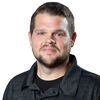






At etrailer.com we provide the best information available about the products we sell. We take the quality of our information seriously so that you can get the right part the first time. Let us know if anything is missing or if you have any questions.








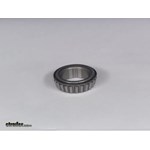




















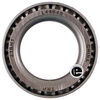

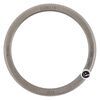
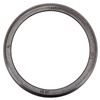
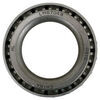
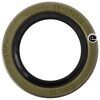

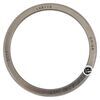






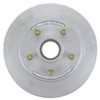










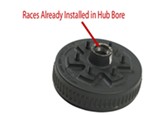
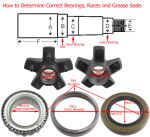

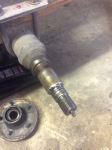
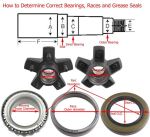
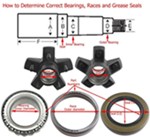
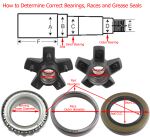
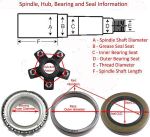
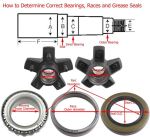
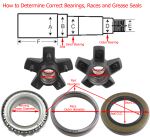
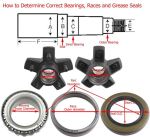
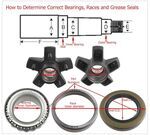

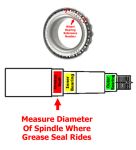
Michael
12/15/2023
They did not get used in a normal way, but performed admirably.